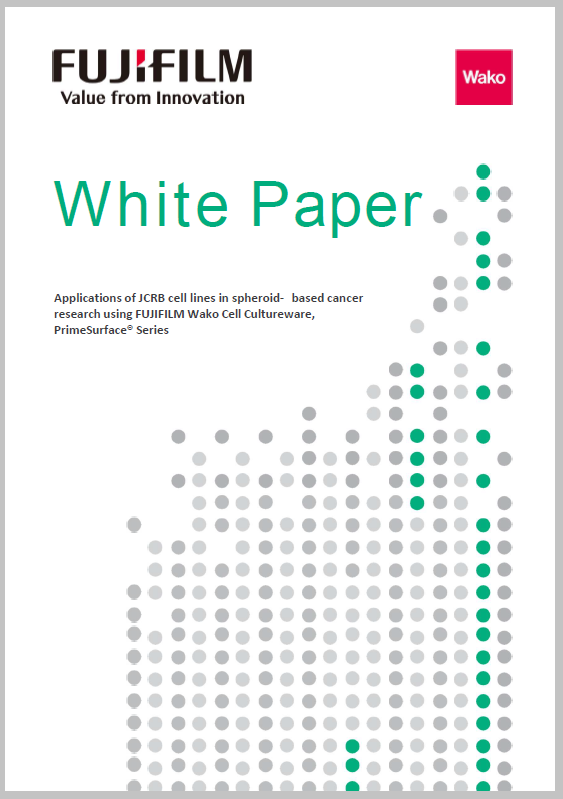Applications of JCRB cell lines in spheroid-based disease research using Fujifilm Wako Cell Cultureware, PrimeSurface® Series
Overview
3D tumor spheroids are cancer cell aggregates formed by 3D cell culture in vitro.1 The growth of spheroids from tumor cells mimics the growth of naturally occurring human tumors, as their extracellular matrix and network of cell-to-cell and cell-to-matrix interactions are similar to in vivo conditions and differ from the corresponding monolayer cultures.2 In addition, spheroids are more stable than monolayer cultures and have a longer lifespan, making them useful for predicting the efficacy and toxicity of drugs in vivo.
Fujifilm Wako provides various cell lines from JCRB, which have high performance in 3D cell culture.
JCRB Cell Lines
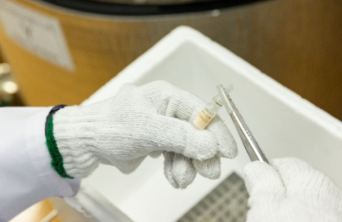
JCRB (Japanese Collection of Research Bioresources) is one of the most comprehensive cell banks in the world for pure and applied science, spanning many fields of research across the globe.
Fujifilm Wako has teamed up with the National Institute of Biomedical Innovation to bring you access to over 1,600 cell lines, which can be used not only as a monolayer cell culture, but also as a 3D cell culture. In Europe, we are the exclusive provider of JCRB's comprehensive catalog of cell lines.
JCRB cell line products in spheroid based research
| JCRB No. | Cell-line name | Profile |
|---|---|---|
| JCRB0182 | KP-4 | Human tumor cell line secreting parathyroid hormone-related peptide (PTHrP) established from pancreatic tumor |
| JCRB0198 | OSC-19 | Human squamous cell carcinoma cell line from tongue tumor with serum free cell culture |
| JCRB1054 | Hep G2 | Hepatoblastoma-derived (previously thought to be hepatocellular carcinoma-derived) cell line |
| JCRB1594 | SK-OV-3/CMV-Luc | Luciferase stably expressing cell line (SK-OV-3; Human ovarian cancer cell line) |
| JCRB9094 | DLD-1 | Adenocarcinoma |
Applications of JCRB cell lines
1. Toxicology and Drug Screening
Tumor spheroid models derived from JCRB0134 (MCF-7) cell lines are used as valuable models for toxicology and drug discovery. They retain their genome over time and can be used to perform drug screening and facilitate patient specific drug development.
2. Benefit of Variety of Ethnic Background in Patient Targeted Cancer Therapies
JCRB offers a highly representative panel of cell lines in terms of ethnic and gender diversity, which could improve the success rate in identifying effective cancer therapeutics in cell culture models and thereby reduce drug failures in diverse human populations.
JCRB cell lines related cell cultureware
Fujifilm Wako provides PrimeSurface® for spheroid culture in regenerative medicine research, including drug efficacy testing and drug screening using 3D models.
PrimeSurface® Series
Enhanced 3D Cell Culturing for Drug Screening and Regenerative Medicine
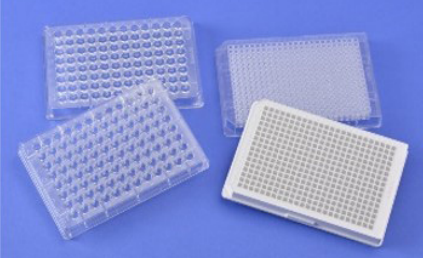
PrimeSurface® is pre-coated cultureware with a unique ultra hydrophilic polymer that enables the spontaneous spheroid formation of uniform size and shape. In addition, PrimeSurface® has high optical clarity, making it suitable for bright field imaging and confocal microscopy. This cultureware is useful in stem cell research, drug discovery and development, and tissue engineering & regenerative medicine.
We offer U and V bottom plates for different cell types and clear and white color for different experiment purpose.
Features
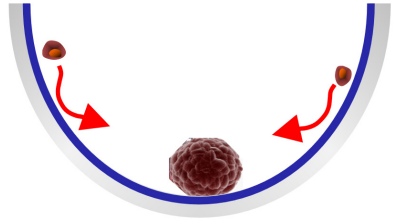
Figure 1 shows single spheroid can be formed in each well.
1. Easy formation of cell aggregates (spheroids)
Spheroids can be obtained easily just by seeding cells into a 96-well plate and culturing them statically.
2. Obtainable uniform spheroids
Prevention of cell adhesion to the culture surface allows spheroids to be cultured with a high rate of uniformity and formation.
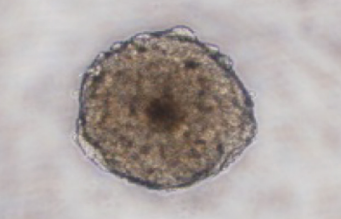
Figure 2 shows spheroid formation can be observed easily.
3. No elution of surface treatment agent
There is no need to worry when eluting of the treatment agent because the surface treatment is chemically bonded to the substrate surface.
4. Less stimulation to cells
It is ideal for cells sensitive to external factors due to the less stimulation from the culture surface.
The inclination of the well bottom allows spheroid formation even in cells with poor cohesion such as MDA-MB-453 and MDA-MB-468. In total Fujiflm Wako offers three well bottom shapes of 96 well microplates.
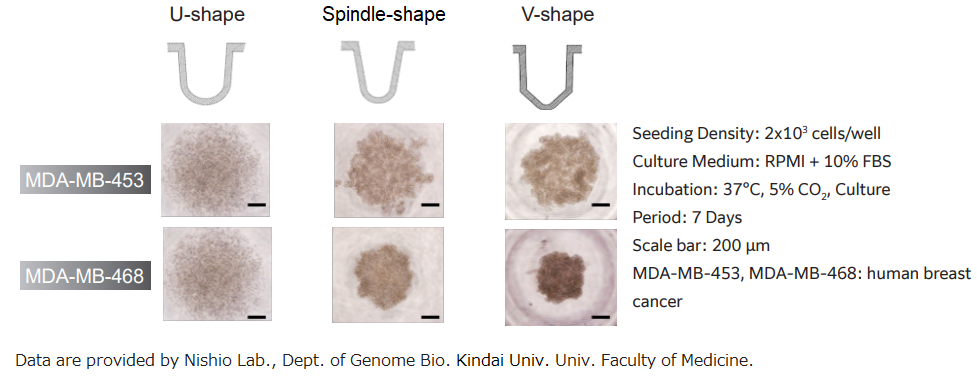
Principle of Spheroid Formation
Time-lapse image of Human iPSCs Spheroid ( EB: Embryoid Body ) Formation

Experimental Conditions
| Culture plate | PrimeSurface® (629-01099) |
|---|---|
| Kind of cells | hiPSCs (DOI 10.1016/j.cell.2007.11.019) |
| Seeding density | 9,000 cells/well |
| Culture medium | DMEM/F12 + 20% (v/v) KSR + 1% (v/v) NEAA + L-Glutamine (2 mM) + β-Mercaptethanol (80 μM) + Y-27632 (30 μM) |
| Culture environment | 5% CO2, 37°C |
| Microscope | BioStudio (Corefront Co.), scale bar 200 µm |
Application Example

 |
Mode of action
|
 |
Mode of action
|
Comparison of cell viability between 5-FU and TPZ

TPZ showed stronger effect in Spheroid than Monolayer. This experiment suggest 3D drug efficacy test environment could be reproduced with PrimeSurface® .
PrimeSurface® 96 Slit-well Plate
In addition to the standard PrimeSurface® portfolio, Fujifilm Wako offers a new design of ultra-low attachment 3D plate to facilitate easy handling of media exchange without disturbing spheroid formation.
Cell culturing involves frequent media replacement to provide nutrition to growing cells. In a standard 96 well ultra low cell attachment plate, media aspiration or dispensing has to be done extremely carefully to avoid disturbing the unattached spheroid, making this a time consuming operation. With the introduction of PrimeSurface® 96 Slit-well Plate, changing the cell culture media for 96 well plates can be efficiently handled within one step dispensing or aspiration for all 96 wells decreasing the pipetting time by over 80% while minimizing the risk of spheroid damage.
Slit-well structure for simultaneous delivery of cell culture medium to all 96 wells

Individual Well Type in conventional plate Slit-well Type Minimize media exchange time without disturbing spheroid formation
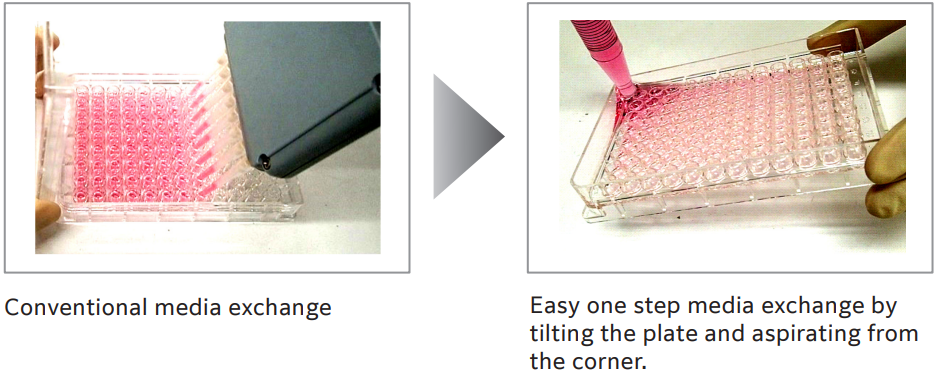
PrimeSurface® products list
| Product Code | Product name | Well type | Well bottom | Color | Size |
|---|---|---|---|---|---|
| 638-49349 | PrimeSurface® 24F Plate | 24 | Flat (1.8 cm2) | Clear | 10 plates / case |
| 635-21039 | PrimeSurface® 96U Plate | 96 | Round | Clear | 20 plates / case |
| 621-01439 | PrimeSurface® 96U Plate | 96 | Round | White | 20 plates / case |
| 628-01449 | PrimeSurface® 384U Plate | 384 | Round | Clear | 20 plates / case |
| 625-01459 | PrimeSurface® 384U Plate | 384 | Round | White | 20 plates / case |
| 622-01109 | PrimeSurface® 96M Plate | 96 | Spindle | Clear | 20 plates / case |
| 629-01099 | PrimeSurface® 96V Plate | 96 | V | Clear | 20 plates / case |
| 633-47839 | PrimeSurface® 96 Slit-well Plate | 96 | Spindle | Clear | 20 plates / case |
Citations
- Li W, et al.: Adv Healthc Mater. 2023 Jul;12(18): e2202609.
- Khaitan D, et al.: J Transl Med. 2006 Mar;4:12.




